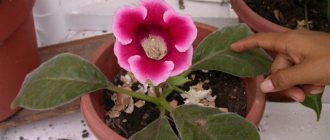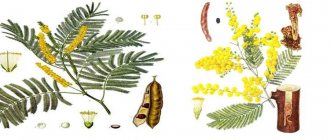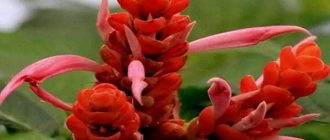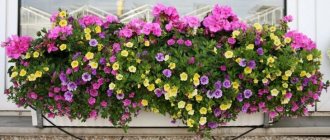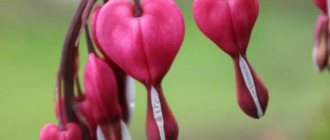Gerbera firmly ranks fifth in the world among the flowers most often used in bouquets. Outwardly similar to a huge daisy, it pleases the eye with the multi-colored color of its petals.
Beautiful and bright, gerbera in a pot is also gaining popularity. What varieties are grown at home, how to care for a flower, what difficulties can you encounter?
Types and varieties of indoor gerberas
More than 80 species of the plant are known, most of them native to South Africa. Not all types of gerbera are suitable for indoor growing. Most often you can find Jameson's gerbera on window sills (see photo).
The powerful tall (up to 30 cm) stem and beautiful oval leaves with carved edges serve as an excellent basis for large flowers of pink, red, orange and white colors.
The golden varieties Kalinka and Jupiter flash on the windowsill like bright sunshine. Pink Viola impresses with its large (up to 10 cm) flower cups. The white varieties Maria and Silvana are most similar to chamomile.
Home gardeners also love bright red Mars. The most popular is Gerbera Mix.
It is not picky to care for, has a low stem, but the main thing is its wide range of colors.
Features of caring for indoor gerberas
Indoor gerbera differs little from other flowers: care at home requires no less attention and care. There are, of course, some peculiarities that are important to know for those who decided to start growing this amazing flower for the first time. Let's take a closer look at how to care for the plant.
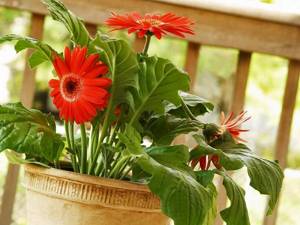
Lighting and temperature mode
Native to South Africa, gerberas love warmth and lots of light. Comfortable temperature for the plant should not fall below +20 °C.
To get enough light, pots should be placed on the south, east and west sides. On hot days, the plant needs protection from the scorching sun so that it does not burn out.
Important! When placed on the north side, year-round illumination is required.
Watering rules
A proper watering regime is the basis for successfully growing home gerberas. Excess and lack of moisture equally negatively affect the condition of the plant. Soil that is slightly dry on top and moist inside is a signal to water.
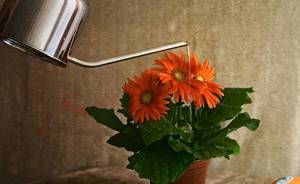
Water the flower with filtered water at room temperature. Alkalis contained in tap water settle in the soil and harm the root system of the plant. In summer, the frequency of watering is increased, and by mid-autumn it is reduced.
When watering the plant, you need to make sure that water does not get on the rosette of leaves. Correctly, when the stream goes into the soil along the inner wall of the pot. The liquid accumulated in the pan must be drained.
Humidity parameters
For successful growth and flowering, the plant requires a humidity of 65–70%. Exceeding this indicator in combination with low temperature and poor air ventilation leads to the development of fungal diseases.
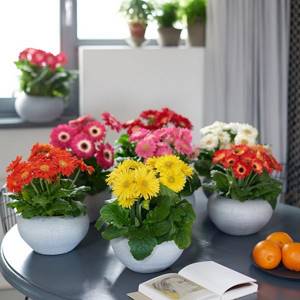
To maintain optimal values, use a humidifier. If you don’t have a device, you can place the pot on a tray with wet pebbles.
Attention! Gerbera does not like spraying. Water getting into different parts of the plant can cause them to rot.
Top dressing
The period of intensive feeding of the plant lasts from the beginning of spring to the end of summer. At this time, it needs complex mineral fertilizers: 1 fertilizing every 2–3 weeks.
In the autumn-winter period, the vegetative processes in the flower slow down, but do not stop. Feeding is continued, but a nutrient solution with a 2-3 times lower content of minerals is used.
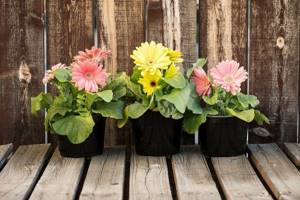
Ill-proper watering causes acidification and salinization of the soil, which prevents the plant from absorbing nutrients. If the soil is severely deteriorated, it must be completely replaced. In case of minor disturbance, remove the top layer and periodically loosen the soil.
Transplantation and soil requirements
A plant needs to be replanted in several cases:
- after the purchase;
- changing the pot to a larger one;
- replacement of contaminated soil.
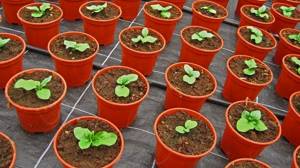
First, let's figure out how to replant after purchase. The new resident of the home garden needs to be given time to adapt. Let it sit in store-bought containers for 3-4 days. In the meantime, you can choose the right pot for it.
The flower loves simple clay containers, not covered with decorative glaze. He can breathe well in them. The soil should consist of leaf soil, peat and hand sand in a ratio of 2:1:1.
Before transferring the plant, the new pot must be doused with boiling water, and drainage (expanded clay or pebbles) must be poured into the bottom.
Having filled the pot with soil, transfer the flower with a lump of earth into it so that the root collar and stem do not go deep. With such planting, moisture will not collect and the plant will not begin to rot.
Important! Adult gerberas are transplanted annually in early spring.
How to transplant correctly: video and step-by-step instructions
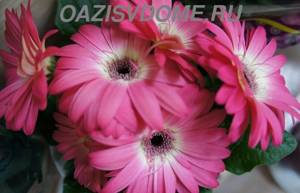
After purchasing a gerbera in a pot, you need to give it two weeks to acclimatize, after which it is recommended to transplant it into a new pot with a nutrient mixture.
Attention! If the condition of the plant you purchased leaves much to be desired, replant it in the next few days, carefully examining the roots during replanting. Bad and rotten roots need to be cut off and sprinkled with crushed activated carbon.
Do I need to replant a purchased flowering gerbera? It all depends on the condition of the flower. If all its leaves are green and it blooms profusely, wait until there is a break in flowering before replanting.
What you will need for transplantation:
- the pot is one to two centimeters wider than the old one and 3-5 cm higher (for drainage and a layer of new soil);
- drainage (expanded clay, perlite, foam in bushes);
- neutral soil for flowering plants;
- settled water at room temperature.
A day or two before replanting, water the flower so that the soil dries out a little and is not too wet. Gerberas should be replanted using the transshipment method.
Step-by-step instructions for transplanting gerberas:
- Place a 2-3 cm layer of drainage on the bottom of the new pot.
- Fill the drainage with new soil with a layer of 2-3 cm.
- Remember the plastic pot with the flower in your hands and carefully pull out the bush.
- Inspect the plant and carefully remove damaged, yellow, rotten or spotted leaves.
- Remove excess top layer of soil, which crumbles easily.
- Place the flower in a new pot and start filling it with prepared soil around it.
- Typically, manufacturers pour the substrate into the flowers right up to the leaves. You need to fill the soil so that it does not touch the foliage, but also buries all the roots.
- Do not compact the soil. Gerberas love loose soil. To make it settle, gently shake the pot.
- Water the transplanted flower by pouring water around the edge of the pot.
- Add soil if necessary.
After transplanting the gerbera into a new pot, keep it in the back of the room in the shade for two days, and then place it in the place chosen for growing it.
Detailed instructions will help you understand when and how to properly replant a gerbera after purchase, and how to care for an indoor flower in a pot at home. Be sure to follow all the care rules and then the beautiful gerberka will decorate your home with beautiful blooms for a long time.
Plant pests and diseases
Hybrid gerbera suffers from diseases and pests no less than other representatives of domestic flora.
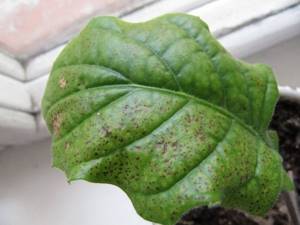
It is important for the flower owner to know the main pests:
- Spider mite. It manifests itself by falling leaves. The main sign of damage is the appearance of a thin transparent web on the underside of the leaf. Develops with insufficient watering. It is destroyed by frequent spraying with clean water and periodic spraying with fungicidal agents (Antiklesch, Neoron, Apollo, Akarin, Fitoverm).
- Whitefly or aphid. Recognized by a shiny coating on the leaves and the appearance of white midges. It is carried in soil contaminated with larvae. Copper sulfate is used to kill the pest.
- Powdery mildew. It looks like a white powdery coating that affects young leaves and the top of the plant. Provoking factors are sudden temperature changes and watering with cold water. Special drugs are used to combat it (Topaz, Fundazol, Fitosporin).
- White and gray mold. Stagnant water in the soil serves as a fertile environment for the pest. The resulting fungus affects the leaves and stems. To destroy mold, spray the plant with a solution (until the color of tea) of Fitosporin, coat the leaves and stem with trichodermine paste.
- Late blight. A fungal disease caused by long-term soil moisture. Appears in the form of small dark spots. If the roots are not dead, you can treat the flower with a fungicide solution (Baktofit, Alirin B, Vitaros, Gamair).
Important! Illiterate care is the main provocateur of gerbera diseases.
Use of the flower
The main purpose of the plant is to decorate the landscape or home. Bushes with large flowers themselves look like small compact bouquets. In landscape design, gerberas are used to decorate borders and mixed flower beds. Its neighbors in the flower bed can be daisies, chrysanthemums, roses, and callas.
Bouquets made from this delicate plant are very popular, because the flowers do not have an intrusive odor and are suitable even for sensitive people. The plant is associated with honesty, tenderness and joy. A gerbera can stand in water for a very long time; the main thing is to properly care for the bouquet. To do this, you need to cut the stems diagonally to increase the area in contact with water. The liquid should be at room temperature. A couple of aspirin tablets are added to it. To prevent the stems from rotting, the water is changed daily.
Main problems when growing
Inexperienced gerbera owners often encounter two growing problems: yellowing leaves and poor flowering. To eliminate them, it is important to know exactly the reasons for the plant’s negative reaction.
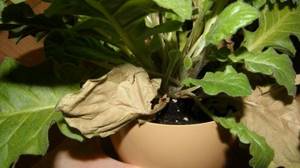
Why do the plant's leaves turn yellow?
Three main factors are to blame for the yellowing of gerbera leaves:
- Excess moisture. When the plant is constantly flooded, the respiration of the root system is disrupted, the leaves do not receive enough nutrients and turn yellow. By reducing the intensity of watering and allowing the soil to dry, you can improve the situation.
- Whitefly. The accumulation of white midges under the leaves of the plant and the appearance of white sticky spots means that they have already laid larvae. The leaves of the plant turn yellow, curl and fall off.
- Dry air and soil. Excessive dryness also causes yellowing of the foliage. Restoring normal watering and using a humidifier will resolve the problem.
Video on how to save a dying gerbera from a store:
How to achieve lush flowering?
The main pride of every gardener is the lush flowering of his pets.
In order for your home gerbera to delight you with bright blooms, you must:
- Provide the plant with 12 hours of daylight. The peak of abundant flowering is from August to November, when the plant has enough natural light. Additional light at other times allows flowering to prolong.
- Feed the flower with mineral fertilizers (potassium nitrate and superphosphate), reducing the number of nitrogen-containing species as much as possible.
- Choose pots that are not too large for planting. When there is excess soil, the plant begins to grow its root system, and it has no strength left to flower.
How to choose when buying in a store?
When choosing a flower in a store, you should pay attention to the color and shape of the leaves. They must be of the correct shape and have a uniform color. It is best to buy a young plant, as it will quickly adapt to new conditions.
You should not choose a gerbera that was close to the door or window - in such places there are sudden changes in temperature, and this may later affect the condition of the flower.
When inspecting the plant, you should make sure that there are no insects or damage on it, and that there are no visible signs of disease.
It is necessary to check the condition of the soil. If the flower is easily reached, this indicates a violation of watering and the death of the root system.
Thus, home gerbera requires special, but not complicated care. The main thing is to observe the temperature regime, soil and air humidity, monitor the lighting and periodically feed the plant. Then it will delight you with inflorescences several times a year.
Acclimatization after purchase
After purchase, the plant should not be disturbed for a week for best adaptation. Place the gerbera indoors without direct exposure to the sun and at a temperature of +12 to +24.
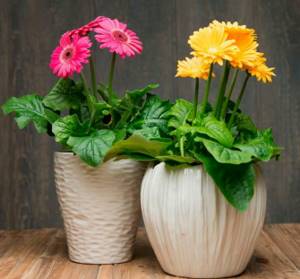
Methods for propagating gerberas
Gerbera can be propagated in three ways: division, cuttings and seeds. Most gardeners prefer the first; others choose cuttings. And only a few are engaged in growing a flower from a seed, since this process is long and labor-intensive. All types of planting are carried out in the spring.
Seeds
To sow gerbera seeds, prepare a special substrate from turf, leaf and humus soil (2:1:1). Add a little sand and sow the seeds into the prepared soil. Water the planting 2-3 times a week. When three leaf blades appear, the seedling is picked.
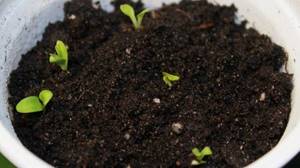
Repeated picking is done after the formation of the fifth leaf plate. Then the small plants are transferred to separate pots. A month later, the first feeding is carried out.
Dividing the bush
For division, you should take gerbera bushes that are three to four years old. Having taken the plant out of the pot, it is disassembled into root lobes. Each lobe should have a growing point and well-developed roots and leaves. Selected plants are transplanted into pots pre-filled with drainage and soil.
Attention! It is not advisable to divide an adult plant during flowering.
